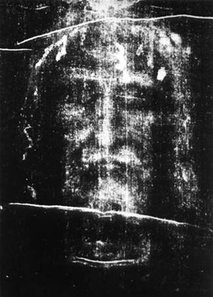Oct 06 2009
Shroud of Turin Reproduced
 The fact that the Shroud of Turin – a linen cloth revered as a relic by the Catholic church that some faithful believe is the actual burial shroud of Christ – is a medieval forgery is old news. But public controversies tend to live long past the scientific controversies on which they are based (creationism, vaccines and autism, HIV denial, etc).
The fact that the Shroud of Turin – a linen cloth revered as a relic by the Catholic church that some faithful believe is the actual burial shroud of Christ – is a medieval forgery is old news. But public controversies tend to live long past the scientific controversies on which they are based (creationism, vaccines and autism, HIV denial, etc).
Italian scientist Luigi Garlaschelli claims to have done what shroud proponents claim was impossible. “We have shown that is possible to reproduce something which has the same characteristics as the Shroud,” he is quoted as saying.
Garlaschelli laid his linen across a volunteer (whose face was covered with a mask) then essentially did a rubbing of their face, and then did some aging on the cloth, adding some blood stains and burn marks. The result is a good copy of the original shroud.
Over the years proponents claimed there was no way an artist could have created the shroud and that its characteristics result from a sudden burst of energy – a speculative hypothesis without confirming evidence. It was also an argument from ignorance – “we don’t know exactly how the shroud was made, therefore it was a miracle.”
The definitive skeptical treatment of the Shroud of Turin was done by Joe Nickell, who wrote Inquest on the Shroud of Turin. He has also reproduced shroud-like images using a rubbing technique.
The science of the shroud is a classic example of the difference between objective science and ideological pseudoscience. Scientists and historians who have examined the Shroud have discovered the following things:
The shroud first surfaced in the middle ages, in the 14 century, during a time when many fake relics were surfacing (a veritable cottage industry of fake relics) often used for fund raising. Investigations at the time found the shroud to be a fake. Bishop D’Arcis investigated the shroud and concluded: “Eventually, after diligent inquiry and examination, he discovered how the said cloth had been cunningly painted, the truth being attested by the artist who had painted it, to wit, that it was a work of human skill and not miraculously wrought or bestowed.”
Chemist Walter McCrone found not human tissue or blood on the shroud, but red ochre and vermilion paint, consistent with what would have been available a the time.
The depiction of Christ is consistent with the artistic traditions of the time.
The “rivulets of blood” apparently falling down Christ’s hair is implausible – blood would have soaked in, not run in rivulets.
Radiocarbon dating of the shroud by three independent labs resulted in dates from 1260-1390.
What we have, then, is multiple independent lines of evidence all pointing to a 14th century forgery. Specifically, the carbon dating points to the same period of time as when the shroud first appears, a period of time rife with fake shrouds and other relics, and consistent with the materials and artistic traditions evident in the shroud. This is a remarkable consilience of evidence.
However, evidence will not end a public controversy where there are strongly held emotional beliefs. So-called “shroud scientists” have tried to dispute this evidence. Working backward from their desired result (that the shroud is the genuine burial shroud of Christ) they have tried to dispute every claim in a series of special pleading. For example, they claim that the carbon dating is inaccurate because of contamination. Contamination may alter carbon dating, but the shroud would have to be dripping with it in order for the date to be as far off as they claim it was. And it would have been a terrible coincidence if the contamination put off the date the exact amount to align with the date of the confessed forgery.
Garlaschelli’s efforts are interesting, if they hold up, and his claims are highly plausible and consistent with the efforts of others. He recognizes, however, that it won’t end the controversy.
“If they don’t want to believe carbon dating done by some of the world’s best laboratories they certainly won’t believe me,” he said.






